We’re having a lot of fun socializing here in San Diego, so completing my river cruise posts has become a challenge. But I have to hurry up or risk forgetting what we did just this past October! Be prepared for a lot of pictures, for this post is loaded with them. So enjoy your favorite beverage as you scroll along…
This is the 5th of 6 installments covering our European river cruise:
- For Grand European River Cruise Part 1 click here
- For Grand European River Cruise Part 2 click here
- For Grand European River Cruise Part 3 click here
- For Grand European River Cruise Part 4 click here
Wurzburg, Germany
Surrounded by Franconian vineyards, Wurzburg was heavily damaged during WWII and has since been completely restored — including the most pristine example of pomp and glory, the Bishop’s Residence Palace, a UNESCO World Heritage Site.
Visiting the palace was an included tour, and this was the only one for which we gave the guide low marks. She seemed very knowledgable but just didn’t communicate information to the guests very well. She was a transplant from Australia, giving tours about Germany to mostly American tourists and a few Filipinos. Something got lost in translation there!
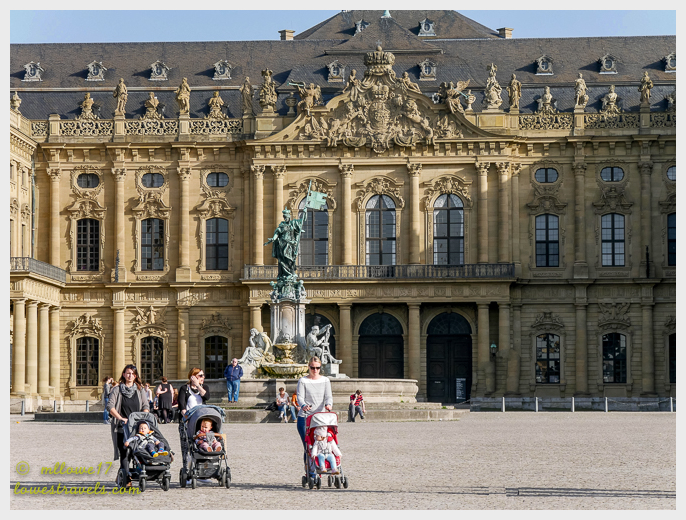

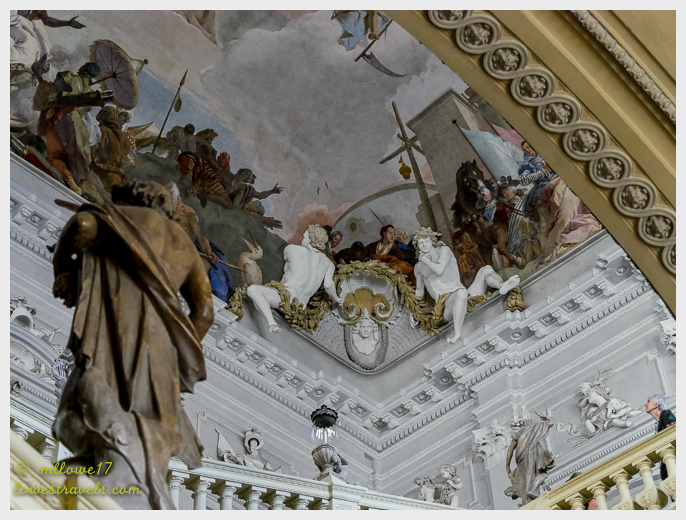




Architectural splendors are part of Wurzburg life:
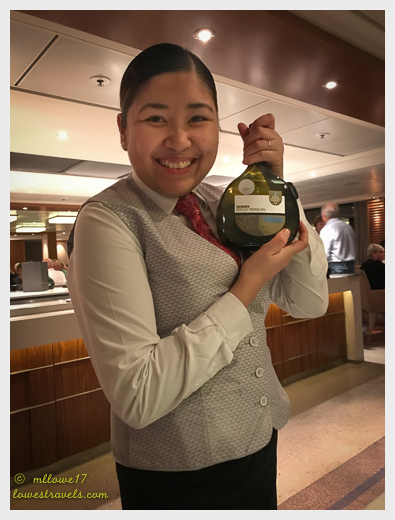
Wertheim, Germany
When a town sits at a confluence of two major rivers, stories of epic floods over the centuries dominate local conversations. The tiny town of Wertheim has been affected many times, being located where the Main (pronounced Mine) River meets the Tauber River. Several markers in the town show just how high the waters have crested over the past 800 years, and exhibits detail how residents have coped and helped one another.

The town is so small and charming that it’s nearly impossible to get lost!
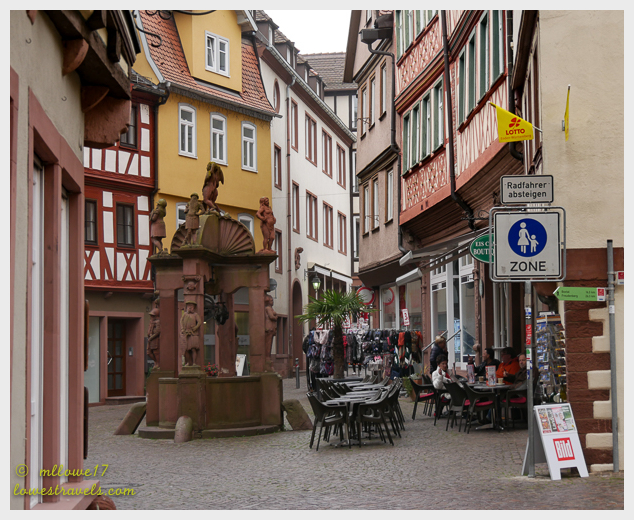

Our guide Ursula was a character, and her knowledge, passion and humor made this a great walking tour. At one of the stops she pointed out that the dog in the display below appears to look at you no matter where you are in front of it, just like the Mona Lisa. The whole crowd had a good laugh when I jumped up and told her that was my name!

Even on a foggy day we decided to climb the hill to see ruins of the Wertheim Castle that overlooks the small town:

Koblenz, Germany
The included tour on our first stop on the Rhine river was a visit to the only castle in the Rhine Valley to have never been destroyed. We were bussed to Marksburg Castle, which watches over the town as it has since the 13th century.

The castle was originally built in 1117 to protect landowner’s harvests, hired hands and the town of Braubach. As times changed it became a prison and then a home for disabled soldiers.

It’s strategically located on a 550′ perch to see incoming enemies from all directions
Unlike others we visited, this castle was not a place of luxury. Yes, there were a lot of rooms but the multiple gates, fortifications, cannonades and a torture chamber indicated it was a fortress for protection.

Today the castle is home to the German Castles Association, which works to preserve medieval fortifications all over Germany.
Cologne, Germany
Our final stop in Germany brought us to a city with a million inhabitants, Cologne (or Koln). It was founded by the Romans in 50 AD and during the Middle Ages flourished as one of the most important major European trade routes between east and west. It was also one of the most heavily bombed cities in Germany during World War II.


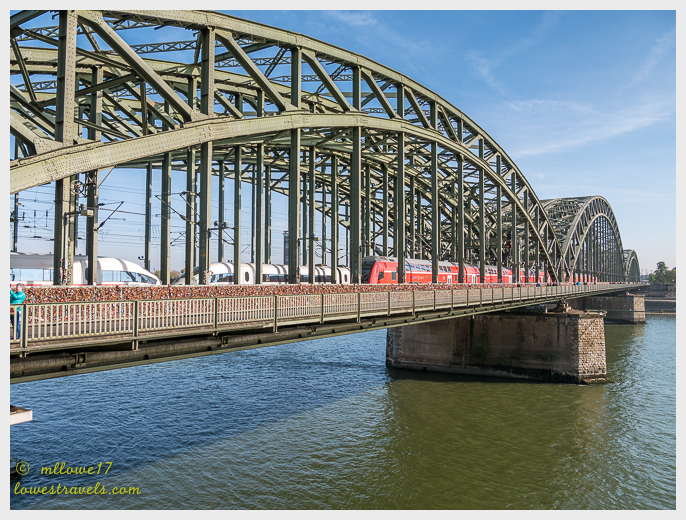
For many years, “love locks” have been considered one of Cologne’s most charming traditions. As proof of their love, couples fix padlocks to the railings on the Hohenzollern Bridge; to ensure everlasting love, they then throw the key into the Rhein river below:
But what survived and was spared by Allied bombs is the 14th century Cologne Cathedral that towers over the Old City and a treasured heritage. Construction began in 1248 and continued in stages over six centuries, with final completion in 1880. It is the largest gothic cathedral in northern Europe, and a magnificent church with two soaring spires that are visible for many miles.


I was so overwhelmed when we stepped inside that I forgot it was a house of worship. Our necks hurt from looking up and around so much. The details were amazing, as the beautiful stained-glass windows filled the interior with brilliant light.


The highlight here was an incredible optional tour that entered the cathedral through a rooftop door via a construction elevator used by restoration crews. We enjoyed amazing up-close views of the cathedral’s gothic architecture as we passed through tight spaces to see the vast tower interiors and massive iron structures holding up the roof. We also visited the restoration workshops before climbing a 104-step spiral staircase for a 360º panoramic view of the city and the Rhine River below. What a wonderful and unique experience!




The views from the top were incredible:


Scenic Rhine River Cruising
The Rhine River begins as a trickle in the Swiss Alps and flows 820 miles through several countries to the North Sea. In the heart of Germany, the Middle Rhine flows past quaint villages, steep vineyards blanketing hillsides, picturesque forest, half-timbered homes, and historic castles and palaces. This stretch of the river Upper Middle Rhine is often called the Rhine Gorge or Romantic Rhine and is also a UNESCO World Heritage Site and you will see below why.
Castles and wines take center stage along this panoramic stretch, and our cruise director called out the names of every property we passed, which added interesting bits of historical trivia about Rhine culture. As we recalled at the beginning, he did mention that the alternate name of the Grand European River Cruise is the “ABC” River Cruise…Another Bloody Castle! This is the Germany once ruled by dukes, brought to magical life by the Brothers Grimm who grew up here and wove fantastic tales from these banks, remember Grimm’s Fairy Tales?

















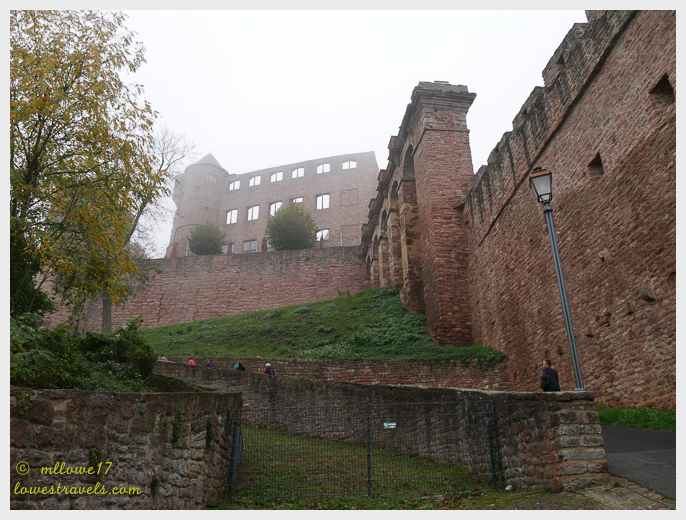





























Another fantastic tour. The Koln Dome is amazing.
Wow… just stunning. From stunningly over the top (the Bishop’s Residence Palace) to stunningly beautiful (the views along the Rhine) to everything in between. What a spectacular place! The Cologne Cathedral is just mind boggling… to think of the generations of people who lived and died while it was being built. Just incredible. Your photos are fantastic. Thanks so much for taking us all along on this tour with you.
Thank you so much for sharing this journey. It’s on my list of things to do when I retire in 2020 and it’s nice to know it’s as beautiful and interesting as I’d imagined.
Fantastic! Now that we’ve booked this cruise for 2018, I’m enjoying your blog posts even more. Such fantastic scenery … and I love those ABC’s. Hope to never have to drive our ‘bus’ down narrow and steep roads … ever.
I must say the Cologne Cathedral was most definitely the highlight of this part of your journey. Wow! What an amazing visit! I can only imagine how spectacular it was in person. Such beautiful photos! You certainly chose the right time of year for the trip down part of the Rhine. The colors are great! Such a special trip for you two.
Haha, I can just imagine you busily sorting through thousands of photos to create this photo journey for us! Thanks for taking us along. That Bishop’s Palace is over-the-top ornate. The scenic Rhine River cruise is my favorite in this part of your travels. How interesting that this was the home of the Brothers Grimm! My mother used to read those fairytales to me at bedtime. 🙂
Just stunning! That restoration was amazing! I love all that detail in the tile work. How very talented and patient those craftsman were back then. I’d love to do this cruise.
Your pictures look like postcard shots MonaLiza! I loved the Cologne Cathedral and your behind the scenes tour above.
This looks so interesting! I love all the amazing historical architecture in Europe. Can you imagine staying at that RV park below the castle?
You have certainly peeked hubby’s curiosity for a River Cruise with these posts MonaLiza. The Bishop’s Palace and Cologne Cathedral are breathtaking. Our architecture pales in comparison to what we have seen in Europe.